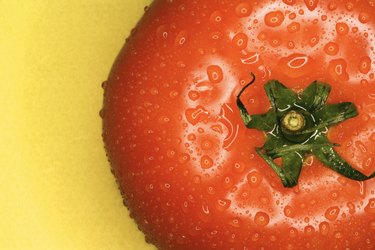
In the world of rapidly progressing agricultural technology, genetically modified foods are the subject of many debates. Tomatoes were the first commercially produced genetically modified, or GM, food. They sparked differing views about the new technology, and initiated the broadening and continuing political, economic and health-related controversy about subsequently developed GM foods.
History
Video of the Day
Flavr Savr tomatoes were introduced to consumers by Calgene in 1994 after receiving the U.S. Food and Drug Administration's approval with the distinction of generally recognized as safe, or GRAS. For GRAS status, a substance must have published, peer-reviewed scientific studies to support its safety status. At the Alliance for Bio-Integrity website, published internal documents between an FDA compliance officer and the FDA biotechnology coordinator in 1992 illustrate how some FDA scientists questioned the wide-reaching new policy that allows GM foods to be approved by the companies that developed them. Risk factors were not addressed in full. Safety evaluations and labeling were not required for GM tomatoes, and companies are allowed to release new GM foods with no public announcement or identification of the product as being GM.
Video of the Day
Flavr Savr Tomato
Flavr Savr tomatoes were created by introducing genetic material that would reverse the natural softening of the fruit. Tomatoes produce an enzyme called polygalacturonase, or PG, as they ripen. It breaks down the cell walls as the fruit ripens, causing the tomato to soften and decay. Genetic material was manipulated to prevent the production of PG. The genes were then cloned and inserted into cells to create Flavr Savr tomato plants. After an initial peak in popularity in GM tomato paste and tomato products, Flavr Savr tomatoes lost economic viability for commercial production, and consumers began to avoid them. They have not been commercially produced since 1997.
Fish Tomato
Another company, DNA Plant Technology, developed another GM tomato that was not economically successful. The company combined genes from an Arctic flounder with tomato DNA in an attempt to create cold-hardy tomato plants. The project was abandoned and the so-called fish tomatoes were never marketed. The controversial transgenic GM processes use genes from one species to be inserted into another species, such as fish genes into tomatoes, creating mutated, damaged DNA and interrupted, unnatural DNA sequences.
Problems With GM Process
Much of the controversy over the safety of genetically modifying foods is because of the process itself. Manipulated genetic material is either "shot" into cells using a "gene gun," or it is introduced into the cells by invasive bacteria that carry the new genetic material and deposit it in the cells. Both methods are unpredictable; they damage the cells, and uncontrollable mutations occur.
- PBS.org: DNA: Hot Science: Gallery of Genetically Modified Tomatoes
- Alliance for Bio-Integrity; Comments From an FDA Compliance Officer About the "Statement of Policy: Foods From Genetically Modified Plants"; Dr. Linda Kahl; January 1992
- “California Agriculture”; The Case of the FLAVR SAVR Tomato; G. Bruening, et al.; July-August 2000
- BioNet: Future Food
- Colorado State University Department of Soil and Crop Sciences; Transgenic Crops: An Introduction and Resource Guide; March 2004
- Institute for Responsible Technology: State-of-the-Science on the Health Risks of GM Foods